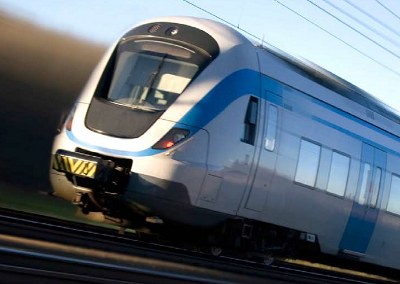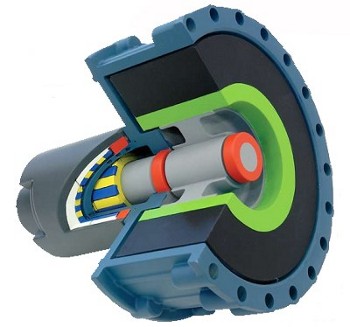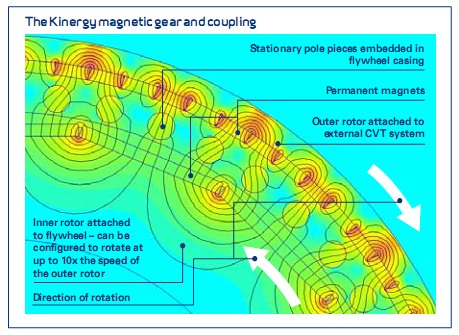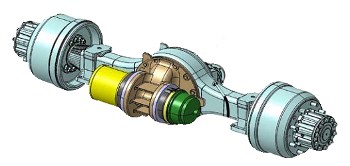 |
| May 07, 2013 | Volume 09 Issue 17 |
Designfax weekly eMagazine
Archives
Partners
Manufacturing Center
Product Spotlight
Modern Applications News
Metalworking Ideas For
Today's Job Shops
Tooling and Production
Strategies for large
metalworking plants
The science of spin: flywheels
Editor's note: Given the recent news about tests showing Volvo flywheel technology can provide up to 25 percent fuel savings for cars, I thought revisting this 2010 Designfax article from Ricardo would be a great way to fill in some additional educational info on developing flywheel tech.
High-speed flywheels are a cheap and efficient way to hybridize systems from cars, elevators, and industrial machinery to inter-city trains. Yet until now their development has been hindered by the lack of a robust way to transmit the power to and from them. Jesse Crosse reports on some ingenious new developments at Ricardo.

Recapturing up to 60 percent of the energy available on each occasion, Ricardo's Kinergy technology fitted to a high-speed train could deliver energy savings of the equivalent of about 75 liters of diesel for each station stop.
Designing products that consume less energy has shot to the top of the agenda in this energy-hungry world -- not just in the automotive business but in any industry delivering mechanical products which do work for our benefit.
Recovering kinetic energy from objects that have been accelerated, and then re-using that energy, is one way of cutting consumption. For example, when a vehicle is accelerated from rest by the engine, the kinetic energy in that vehicle is usually wasted when the time comes to slow down, either through frictional losses and aerodynamic drag when coasting, or heat when braking.
In electric vehicles, this energy can easily be recovered and re-used by using the electric drive motor as a generator to slow the vehicle, generating electricity in the process. In cars, this electrical energy is typically stored in a battery or ultra-capacitor and then re-used when the driver wants to accelerate again, whereas in rail applications electricity can be fed back into the power distribution system via the overhead catenary or conductor rails. However, another and potentially much more cost-effective method, not just for electric vehicles but for those powered by traditional combustion engines as well, is the flywheel.
Flywheels make great children's toys in the form of spinning tops, gyroscopes, and yo-yos, but they are also hugely effective energy storage devices. Decelerate a car by energizing a flywheel rather than wastefully using the brakes, and the energy it stores can be used the next time the driver wants to accelerate.
Hybrids, Formula One, and flywheels
Ricardo has substantial experience in flywheel hybrid system development. It has investigated many different kinds of energy recovery technologies such as ultra-capacitors, hydraulic systems, electric flywheels, and mechanical flywheels -- including the engineering of kinetic energy recovery systems (KERS) for Formula One applications. As a result of this work, Ricardo has devised "Kinergy," a compact, lightweight, high-speed, hermetically sealed flywheel energy storage system concept with a highly innovative and patented magnetic gearing and coupling mechanism.
Modern carbon fiber-based flywheel systems such as Kinergy can typically operate at speeds of around 60,000 rpm. With consequent outer surface speeds of around Mach 2, a vacuum is essential, as friction from any surrounding air would cause the carbon fiber to quickly overheat and de-laminate.
The high power density and long-life potential of Kinergy technology results from its inherent simplicity and effectiveness, avoiding the need for vacuum pumps and seals and offering a robust, compact, and lightweight package. The simplicity of its design also yields comparatively very low projected production costs, thus opening the door to a wide range of potential applications.

The Ricardo Kinergy high-speed, hermetically sealed flywheel energy storage system concept, showing its patented magnetic gearing and coupling mechanism.
The technology appears ideally suited for application in passenger cars ranging from small, price- sensitive mass-market models to large luxury SUVs, enabling the effective hybridization of a wide range of applications where conventional electro-chemical battery systems would be prohibitively expensive. Potential additional Kinergy applications also include low-cost, compact energy management and storage systems for use in industrial and construction equipment and local electrical substations and power distribution systems.
Scalable energy store
A flywheel is a relatively simple energy store. It is scalable, modular, and has a high power density, which means it can absorb and release energy very quickly. Unlike battery systems, with their much higher energy density but much slower ability to absorb and release it over time, modern flywheel systems are thus much closer to ultra-capacitors in operation, making them ideal for delivering short bursts of power, such as during acceleration.
Flywheels are hence, in effect, a complementary technology to batteries, but in an electric hybrid powertrain they offer direct competition to ultra-capacitors, out-scoring them in terms of cost, volume, weight, efficiency, and ease of manufacture. A battery has to be sized for energy capacity, power, and the number of charge and discharge cycles it can withstand. But with the Kinergy system, a continuously variable transmission (CVT) determines power output and the flywheel speed. Both can be optimized to achieve the balance of power and duration of output needed.
Although this approach is entirely mechanical, the flywheel can also be connected to an electric motor-generator and electrical system. It could also be connected to a hydraulic displacement unit rather than a CVT.
Flywheels are extremely versatile devices. In a conventional car, they can be used to seamlessly feed power back into the powertrain, reducing the work done by the engine, saving fuel, and reducing CO2 emissions. In a hybrid or electric vehicle, they reduce the drain on the battery, helping to extend the range.
There are less obvious uses, too. Dual-clutch transmissions (DCTs) are becoming more popular because the lack of torque interruption provides the refinement of a torque converter automatic gearbox with the relative simplicity, efficiency, and packaging benefits of a conventional manual gearbox. The simpler alternative to DCT, the automated manual transmission (AMT), is much cheaper to manufacture and equally efficient: however, it suffers from torque interruption during gearshifts, which often led to poor levels of refinement in fully automatic mode.
Ricardo has a patent pending on a flywheel system which can fill the torque gap as the gearbox shifts. "The system is the same cost as a DCT and just as refined," says Ricardo technical specialist Andy Atkins. "However, because of the added hybrid function, it delivers a 20 percent reduction in fuel consumption as a bonus."
High-energy applications
Beyond the passenger automotive sector, larger units are perfect for use in trucks, buses, and passenger trains which continually accelerate and stop. "Kinergy is tailor made for trains," Atkins continues. "The braking energy of a TGV (bullet train) or large express train represents a huge amount of energy. For example, braking from full speed to rest, a modern high-speed train dissipates about 0.9 gigajoules, which is the energy equivalent of 90 liters of diesel fuel. In this application, Kinergy flywheel systems would energize as the train brakes to a stop and give back their energy as they help to accelerate it away from the station. Recapturing up to 60 percent of the energy available on each occasion, Kinergy technology fitted to a high-speed train could deliver energy savings of the equivalent of about 75 liters of diesel for each station stop.
Flywheels can improve the efficiency of elevators, too. An elevator full of people on its downward journey could store enough energy in a flywheel to allow a lighter passenger load to make the next upward trip for free. Yet, as with any spectacular new technologies, there are some myths surrounding flywheel systems mainly derived from old-fashioned heavy steel flywheels.

Modern devices used in hybrid drivetrains are quite different, explains Atkins. "As Kinergy shows, modern high-speed flywheels can be very small and lightweight. Flywheels only need to be heavy if they are spinning slowly. The idea that they have a detrimental effect on handling is also a myth; as you increase the operating speed, inertia and gyroscopic forces are reduced for a given energy storage capacity. They have no more effect than taking a passenger out of a car."
Manufactured from carbon fiber wound onto a metallic hub or directly onto a shaft, these modern flywheels spin in a vacuum, typically at speeds of around 60,000 rpm. A vacuum is essential. With a surface speed of Mach 2, friction from any surrounding air would cause the carbon fiber to quickly overheat and de-laminate.
Powertrain integration
Flywheels are usually integrated directly into a powertrain; one example being the rear axle of a rear-wheel-drive car. The Kinergy flywheel system incorporates a small Torotrak continuously variable transmission, through which torque passes to the flywheel from the driveline, then smoothly from the flywheel back into the driveline whenever required. The huge rotational speed of the flywheel must be reduced before its power can be transmitted to the driveline. One way of doing this is by conventional gears, but at those speeds there are issues of frictional losses, wear, lubrication, the transmission of vibration, and foreign bodies finding their way between the gears.
Some of the original motorsport designs were like this, harvesting and delivering torque via gears -- a system that, although acceptable, has drawbacks for everyday use. A shaft leaving the vacuum chamber passes through a seal which inevitably leaks slightly. The faster the flywheel spins, the more the seal leaks, necessitating a vacuum pump to maintain the vacuum and introducing the need for maintenance. So Ricardo came up with a better idea, a magnetic gear which allows torque to be transmitted from inside the vacuum without penetrating the seal.
The magnetic gear can be configured to give a reduction of 10:1, so if the flywheel is revolving at 60,000 rpm, the output shaft can revolve at 6,000 rpm, significantly reducing windage losses. Magnetic gears use permanent magnets to transmit torque through an airspace between two shafts, without the need for mechanical contact.
Ricardo's system comprises a rotor on the output shaft of the flywheel rotating inside a cylindrical rotor on the power-take-off shaft. An array of permanent magnets is set into each, and it is the attraction between the magnetic fields of these magnets that links the rotation of one shaft to another.
One inherent difficulty in engineering this arrangement is achieving close enough proximity of the magnets for the principle to work, given the thickness of the casings. The peak field distance is at around a millimeter, so the optimum distance between the two arrays of rotating magnets would be around double this -- not enough to maintain an acceptable air gap and casing thickness. But installing ferrous pins in the casing wall transmits the magnetic field and the wall effectively disappears, allowing acceptable air gaps to be incorporated within a comfortable engineering tolerance. Efficiency is extremely high at more than 99.9 percent, and the system is robust, too. In the event of a serious torque spike, there are no gears to shear. Instead, the magnetic connection will slip and is quickly re-instated by simply backing off the torque.
Safety factor
Achieving a sufficiently high safety factor in such high-speed components is clearly important. Kinergy's carbon fiber flywheel has a margin of 12 times the ultimate tensile strength (UTS), or in other words, it is being stressed to one-twelfth of the UTS of the carbon fiber material. The design is such that failure modes can be detected by the automatic monitoring of out-of-balance vibration by bearing sensors, enabling safe shut down before further consequential damage is caused. In the worst case, the external casing would, in any case, contain any failure.
The major challenges will come with mass production, says Atkins. "Although relatively cheap to make in principle, winding the filament onto a bobbin is relatively time consuming. This means that increasing volumes in the production process may be a challenge."
Yet Kinergy is cost effective, and it is estimated an entire unit integrated with a differential could be made for around $1,500. The flywheel and CVT represent about a third each of the cost, with the differential and other equipment making up the rest. The unit would be substituted for the standard differential, so there are savings to be made there, too.
Bearings are the only limiting factor, and in practice these will ultimately decide the service life of the unit. The current state of the art is to use ceramic balls and steel races: these already last the life of the system. The only service requirement would be to reinstate the vacuum, as the composite material used to make the flywheel seeks to balance its own internal water content with the atmosphere around it and water will continue to "boil" out for some time.

The highly compact Kinergy system as integrated into a rear axle assembly.
"This is all standard vacuum engineering practice, though," says Atkins, "It's a simple job which involves plugging in a vacuum line during a routine service. If we didn't have the magnetic coupling, however, then we'd be doing that every couple of hours and you would need an on-board vacuum pump."
The rotating seals of a mechanically geared system would also wear, so the problem would get worse with time. Replacing these gears would involve a total break into the vacuum, with inevitable water ingress into the system and the pump would have to work a lot harder.
To remove the need for any kind of maintenance, Ricardo has also developed a solid-state pump which would mean never having to do anything at all. Known as "getter" technology, Atkins explains that this currently highly confidential technology is extremely promising: "It absorbs just about everything except hydrogen in a physical rather than a chemical process," he says.
Many potential applications
The list of applications is extensive, concludes Atkins, since flywheels are ideal for anything that involves intermittent flows of high power. "Flywheels are particularly good for vehicles that stop often -- and the heavier the better," he says. "So cars, trucks, trains, trams, buses, materials handling machinery such as cranes and elevators and even White Van Man [English slang for work-van drivers], as it works brilliantly for delivery vehicles! They're also good for electrical power management systems where highly intermittent demands need to be smoothed, such as local distribution grid or railway substations, in particular, for example, mass transit and metro power networks which are required to manage regenerative braking loads from rolling stock being fed back into the conductor rails or overhead lines."
"Ricardo's Kinergy technology is inherently cost effective, robust, reliable, and compact, giving it a huge potential for many such applications. Its highly compact size and light weight also makes it an ideal candidate for aftermarket system integration without affecting the original equipment design, on anything that requires a pulse of energy," Atkins adds.
Without any doubt, the future looks good for flywheel technology. Proof comes in the form of the inquiries that are flooding in to the Ricardo offices as more people begin to understand that, when it comes to reducing energy consumption, few devices are quite so elegant in their simplicity, their efficiency, and their cost effectiveness, too.
This article was originally published in the Ricardo Quarterly review magazine, RQ. Re-published with permission and gratitude. For further information contact media@ricardo.com.
Published May 2013
Rate this article
View our terms of use and privacy policy
